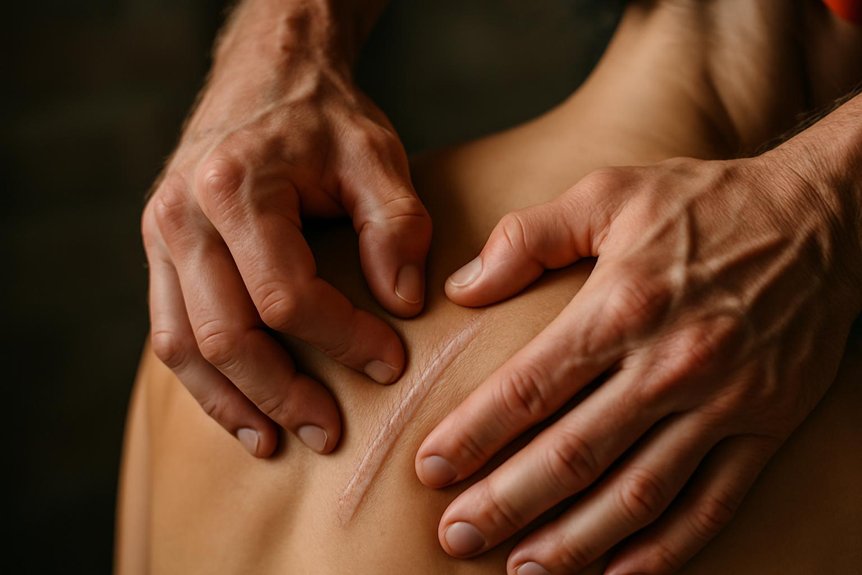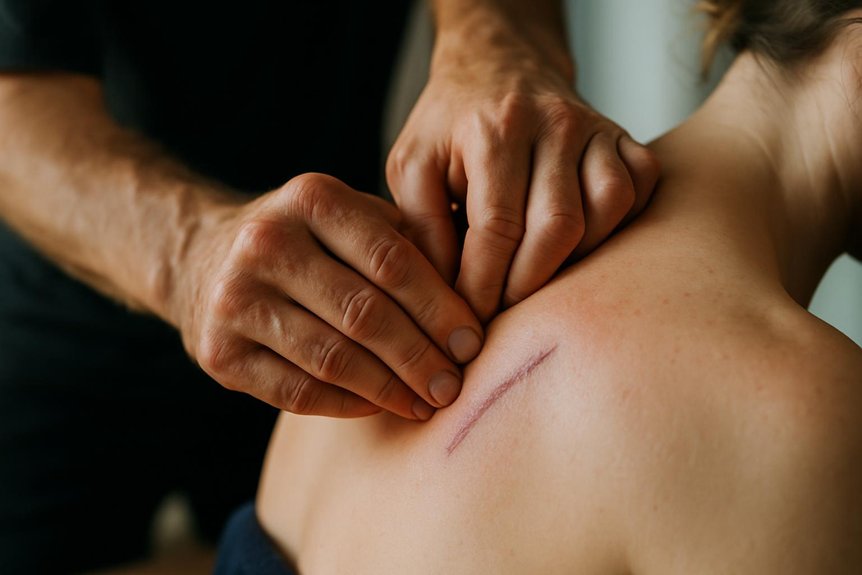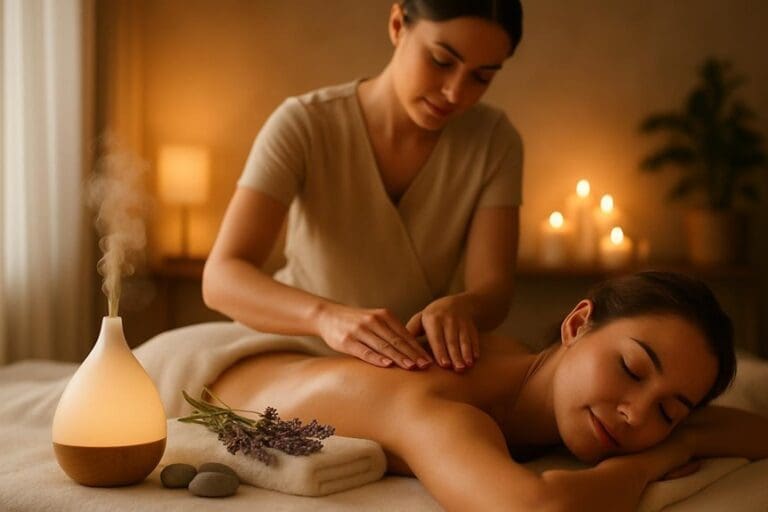It cannot completely eliminate scar tissue, but it can break down adhesions, improve tissue flexibility, and increase scar mobility. By applying sustained, targeted pressure, therapists encourage collagen fiber realignment, soften dense tissue, and enhance local circulation to support natural healing. Techniques are individualized based on the scar’s age and tissue response, often resulting in greater comfort and improved function. Those seeking a more thorough understanding of how massage aids scar recovery will find further insights ahead.
Understanding Scar Tissue and Its Formation

When the body experiences an injury—such as a muscle strain, surgery, or repetitive microtrauma—the healing process initiates the rapid production of collagen fibers. Unlike the organized alignment of healthy tissue, these new fibers form haphazardly, creating dense, less flexible scar tissue. Over time, this tissue can restrict movement, reduce elasticity, and sometimes contribute to discomfort or chronic pain. Scar tissue lacks the functional properties of original tissue, often leading to a sensation of tightness or altered sensation in affected areas. At Spa & Massage, therapists recognise how this process can affect wellbeing, guiding clients toward treatments that support comfort and mindful recovery, always addressing individual experiences and concerns with sensitivity and expertise. Many people find that the focused pressure and slow strokes used in deep tissue massage can help break down adhesions within scar tissue and promote greater mobility.
How It Works on Muscles and Connective Tissue
It applies sustained pressure to reach deeper layers of muscles and connective tissue, specifically targeting areas of muscle adhesions and restriction.
This technique is designed to enhance tissue flexibility and restore normal movement patterns by breaking down dense scar tissue and realigning fibers.
Additionally, increased blood circulation is facilitated, supporting nutrient delivery and tissue repair for ideal client outcomes.
Targeting Muscle Adhesions
Precisely targeting muscle adhesions, also known as “knots,” is central to the effectiveness of intensive tissue massage as practiced at Spa & Massage clinics. These adhesions occur when muscle fibers and connective tissue bind together following injury, overuse, or tension.
Often resulting in discomfort and restricted mobility, these adhesions can significantly impact a client’s well-being. Skilled therapists at Spa & Massage systematically locate and address these areas using slow, deliberate strokes and sustained pressure, aimed at breaking down adhesions without causing undue discomfort.
By focusing on the deeper layers of muscle and fascia, they facilitate the release of chronic tension and encourage improved tissue alignment. This targeted approach not only relieves pain but also supports the natural healing response.
Clients can then experience a sense of relief and restoration within a nurturing, attentive environment.
Enhancing Tissue Flexibility
When muscle fibres and connective tissues such as fascia become restricted—often due to injury, repetitive strain, or inactivity—tissue flexibility is compromised, leading to reduced range of motion and discomfort.
Intensive tissue massage, as practised by Spa & Massage therapists, aims to address these limitations by applying sustained, focused pressure to deeper layers of musculature and fascia. This technique targets areas of restriction, encouraging the breakdown of adhesions and restoring pliability to tissues.
Clinical evidence suggests that repeated, skillful manipulation of muscle fibres supports improved extensibility and elasticity. Clients often report perceptible changes in joint mobility and muscle suppleness following targeted sessions.
At Spa & Massage, therapists tailor their approach to each individual’s needs, ensuring an experience that nurtures both physical function and a sense of personal well-being.
Promoting Blood Circulation
Following improvements in tissue flexibility, the physiological benefits of targeted massage extend further through enhanced blood circulation within muscles and connective tissues.
Intensive tissue massage applies sustained, focused pressure to deeper layers of muscle fibers and fascia, prompting vasodilation and increased capillary permeability. This process facilitates the delivery of oxygen, nutrients, and immune cells critical for cellular repair and scar tissue remodeling.
At Spa & Massage, therapists employ precise techniques tailored to each client’s needs, optimizing the circulatory response while minimizing discomfort.
Enhanced perfusion not only accelerates metabolic waste removal but also supports the body’s natural healing mechanisms and reduces localized inflammation.
Clients frequently report a sense of warmth and revitalization, reflecting the improved microcirculation resulting from expertly administered intensive tissue massage.
The Effects of Intensive Tissue Massage on Scar Tissue

Intensive tissue massage applies sustained pressure and slow, targeted strokes to the deeper layers of muscle and connective tissue.
Scientific research indicates that this approach can encourage the realignment of collagen fibers within scar tissue, supporting improved flexibility and function in the affected area.
By breaking down adhesions and facilitating local circulation, intensive tissue massage helps to soften and mobilize scar tissue, reducing discomfort and limiting restriction.
At Spa & Massage, therapists carefully assess each client’s presentation, adapting their technique to suit individual healing stages and tissue sensitivity.
The result is often a gradual restoration of suppleness and ease—helping clients reconnect with their bodies and move with greater confidence and comfort in daily life.
Techniques Our Therapists Use to Address Scar Tissue
At Spa & Massage, therapists employ a combination of targeted pressure application, myofascial release methods, and specific stretching and mobilisation techniques to address scar tissue effectively.
These approaches are designed to improve tissue pliability, reduce adhesions, and restore functional movement.
Each technique is selected based on clinical assessment and tailored to the unique needs of the client.
Targeted Pressure Application
Precisely applied pressure forms the cornerstone of effective scar tissue management at Spa & Massage clinics. Therapists utilise deliberate, focused techniques to reach underlying adhesions without overwhelming delicate tissues.
This approach involves calibrated force, systematically increasing intensity to match the client’s tolerance and tissue response. By isolating scarred regions, practitioners stimulate localised blood flow and cellular regeneration, which can encourage gradual softening of fibrous tissue.
Clients experience a tailored session, where therapists continually adjust pressure based on verbal feedback and subtle changes in tissue texture. The goal is to disrupt restrictive adhesions while maintaining client comfort and trust.
This targeted method supports both functional improvement and enhanced sensation, aligning with Spa & Massage’s commitment to personalised, restorative care for those seeking both therapeutic results and an intimate, attentive experience.
Myofascial Release Methods
While addressing scar tissue, myofascial release methods are employed by Spa & Massage therapists to improve tissue mobility and reduce discomfort. These techniques involve sustained, gentle pressure and precise stretching to target fascial adhesions, which often develop around scar tissue following injury or surgery.
Evidence suggests that myofascial release can decrease pain and increase flexibility by encouraging fluid movement and promoting collagen realignment. At Spa & Massage clinics, therapists carefully assess the client’s tissue response, adapting pressure and hand placement to respect individual sensitivities and healing stages.
Clients frequently report a sense of relief and greater ease of movement after these sessions. The approach is deeply personalised, fostering trust and safety while supporting ideal tissue recovery and a more comfortable, connected physical experience.
Stretching and Mobilisation Techniques
How do targeted stretching and mobilisation techniques support scar tissue recovery?
At Spa & Massage, therapists implement specific stretching protocols and joint mobilisation to address restricted range of motion and tissue adhesions commonly associated with scar tissue formation.
These techniques enhance flexibility by lengthening affected muscle fibres and encouraging realignment of collagen, reducing the risk of further contractures.
Evidence indicates that gentle, progressive stretching, combined with mobilisations, improves tissue pliability and functional integration.
Therapists assess each client’s needs, customizing interventions to optimise recovery while minimising discomfort.
Regular application of these methods, as part of an extensive treatment plan, promotes circulation, supports lymphatic drainage, and accelerates healing.
Clients frequently report increased comfort and improved movement, reaffirming the value of this evidence-based approach in scar tissue management.
Potential Benefits and Limitations of Massage for Scar Tissue

Although it is frequently utilised as a supportive intervention in the management of scar tissue, its effectiveness is influenced by several factors, including scar age, location, and individual tissue response.
Scientific studies indicate that massage may enhance local circulation, reduce adhesions, and promote tissue pliability.
In Spa & Massage clinics, therapists apply targeted techniques to address stiffness and discomfort, aiming to support functional recovery and restore comfort.
However, it is important to recognise that this type of massage is unlikely to fully eliminate mature or extensive scar tissue.
Outcomes are typically ideal when therapy is initiated during the early remodeling phase of healing.
Clients may notice improvements in flexibility, texture, and sensation, yet results vary.
A personalised, consistent approach is essential for best outcomes.
What to Expect During and After Treatment
Clients seeking intensive tissue massage for scar tissue management at Spa & Massage clinics can anticipate a structured, therapeutic approach tailored to their individual needs. Initial consultations involve assessment of the scar’s age, location, and tissue characteristics.
Therapists employ precise techniques such as slow, targeted strokes and sustained pressure, focusing on mobilizing adhered tissues and promoting pliability. Communication is encouraged throughout, ensuring comfort while optimizing therapeutic outcomes.
During treatment, some clients may experience mild discomfort, warmth, or a sensation of tissue release. Post-treatment, it is common to notice temporary tenderness, redness, or slight swelling in the targeted area as circulation increases. These responses typically subside within 24-48 hours, reflecting the body’s adaptive healing processes facilitated by professional intervention.
Aftercare and Supporting Scar Tissue Healing at Home
Ideal scar tissue recovery relies not only on professional intervention but also on consistent, informed aftercare at home.
At Spa & Massage, therapists emphasise maintaining tissue mobility through gentle self-massage and prescribed stretching routines. Hydration and balanced nutrition support collagen remodelling, while avoiding undue strain on the affected area prevents re-injury.
Application of recommended moisturisers or oils—such as those used in Spa & Massage clinics—can aid skin pliability and comfort. Clients are advised to monitor for signs of irritation or inflammation, seeking guidance promptly if concerns arise.
Integrating relaxation techniques, such as mindful breathing, promotes systemic healing and stress reduction.
Adhering to these aftercare protocols fosters ideal tissue regeneration and complements the benefits attained through professional intensive tissue massage sessions.
Conclusion
Just as gentle currents wear smooth the edges of a stone, intensive tissue massage, applied with clinical precision, can encourage scar tissue to soften and integrate. While it may not erase scars entirely, evidence suggests that skilled manipulation helps restore mobility and comfort, supporting the body’s natural healing tides. Clients at Spa & Massage receive tailored care, ensuring each session is a measured step toward renewed freedom of movement and improved well-being on their journey of recovery.



